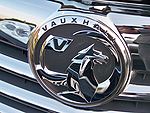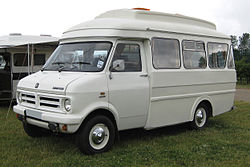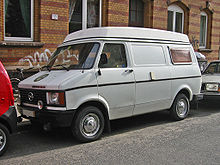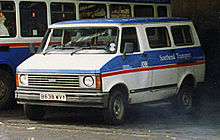- Bedford CF
-
Bedford CF Manufacturer Bedford Vehicles Also called Bedford Blitz Production 1969–1988 Predecessor Bedford CA Class Light commercial vehicle Body style Van Layout Longitudinal front engine, rear-wheel drive Engine Slant Four
1.6 L
1.8 L
2.0 L
2.25 L
2.3 LTransmission 3-speed manual
4-speed manual
5-speed manual
3-speed automaticWheelbase 106–140 in (2,692–3,556 mm) Related Bedford Dormobile
The Bedford CF was a model of light commercial vehicle produced by Bedford Vehicles for almost twenty years from the late 1960s. In Germany and certain other continental markets, the CF was sold through Opel dealers as the Opel Bedford Blitz from 1973 on.Contents
CF
Introduced November 1969[1] to replace the 17 year old Bedford CA, the CF van variants soon became some of the most popular light commercial vehicles on British roads.
The CF could be specified with a sliding door in the side panel directly behind the passenger door,[1] and it was generally with this layout that the van was also commonly used as a base vehicle for a caravanette.[2]
The engine was the well-proven Slant Four engine which was introduced for the Vauxhall FD Victor models in 1967. Apart from an increased engine capacity from 1.6 l (1,598 cc) to 1.8 l (1,759 cc) units and from 2.0 l (1,975 cc) to 2.3 l (2,279 cc) in 1972, the power units remained unchanged. A four cylinder 1.8 l (1,760 cc) Perkins diesel engine could be specified for an extra GB£130 (1969),[1] while a larger 2.5 l (2,523 cc) version was used for heavier versions. In 1977, a 2.1 l (2,064 cc) overhead valve (OHV) diesel engine from Opel replaced the outdated Perkins units.
In Australasian markets, the CF could be optioned with Holden six-cylinder units, in 2,850 cc (173.9 cu in) and 3,310 cc (202.0 cu in) forms. This was as an answer to the rival Ford Transit range, which in Australia used six-cylinder engines from the Ford Falcon vehicles.
The Bedford used the same basic suspension lay-out as the Vauxhall Victor, though married to greater wheel arch clearances and calibrated for greater weight carrying capacity.[3] The front independent suspension featured a double wishbone layout with coil springs and telescopic shock absorbers, while the rear wheels were suspended by a combination involving a live axle and traditional long single-leaf springs.[1]
Several different manual transmissions were used, namely the Vauxhall three-speed, four-speed, Bedford four-speed, ZF four-speed, ZF five-speed, and the General Motors automatic. The Laycock type of overdrive was available to order or on the later Vauxhall four-speed models.[2]
There were three CF1 body styles. A standard panel van which was intended to rival the Ford Transit; the special van body (essentially a self-contained cab with a general-purpose chassis onto which a wide range of custom-built bodies or beds could be built), and the Dormobile (caravanette).
CF1 "facelift"
The CF series 1 facelift was introduced in 1980, introducing the 2.3 L (2,260 cc) Opel 23D diesel engine with 61 hp (45.5 kW).[4] Units exported to Germany (Bedford Blitz) received a smaller, 2.0 L (1,998 cc) diesel, producing 60 PS (44 kW; 59 hp).[5] The 1.8 and 2.3 litre petrol units remained the same. (The CF1 "facelift" is often confused with being a CF2 because it's difficult to tell them apart from the exterior.)
CF2
In 1984 the CF was re-named CF2 and basically only received mechanical upgrades. The diesel engines remained the 2.3 (with the 2.0 available in continental Europe) but the old Vauxhall slant fours were replaced by a 2.0 L (1,979 cc), 78 hp (58 kW) version of General Motors' corporate cam-in-head four cylinder.[4].
New transmissions were also available:
• 4-speed GM all-synchromesh gearbox on short wheelbase models;
• ZF 5-speed overdrive all-synchromesh gearbox standard on all long wheelbase models and optional on others;
• GM automatic transmission optional on most models;
• Choice of axle ratios on nearly all models.
And new efficient brakes:
• Front disc brakes with self-adjusting rear drums on CF2/230 to CF2/280;
• Self-adjusting drums all around on CF2/350 models;
• Load-sensing valve standard on all models.
In 1985 the CF2 was sold side by side in UK with the rebadged Bedford Midi. By then the CF's replacement was put on hold and then ultimately dropped when Bedford decided that rebadging other GM owned brands was much cheaper. The last CF2's were sold in the UK in 1987 and marked the end of original Bedford designed vehicles.CF Electric
One noteworth point was in 1982 with the introduction of the CF Electric, the first mass produced electric driven fossil fuel derived vehicle. It was built in partnership between Bedford, Lucas, Chloride Group and the UK Government on a 5 year grant scheme. The batteries where housed in a compartment below the floor and the traction came from a motor placed at the rear with a step down reduction gearbox coupled to the CF's standard differential, but turned through 180' The motor control system was housed under the bonnet and a small diesel heater provided cabin heating. The system also featured regenerative braking, however this could be turned off as it was found that in wet conditions the motor could lock the rear wheels similar to applying the handbreak. Most where sold to government agencies, the Royal Mail and local authorities. However with a price tag much higher than a standard CF, and battery technolgy at the time not advancing the government scheme wound down in 1987, and the model was withdrawn and spares for it soon dried up.
Commercial
The Bedford CF van was the second most popular van in the UK, second only to the Ford Transit. Along with the Transit, the CF was usefully wider than competitor vehicles from Austin-Morris, Rootes and Volkswagen.[6] It was also the most common caravanette. CFs were popular with customisers throughout the 1970s and 1980s.
Users
The Bedford CF was widely used. The British police, in particular, used them for prisoner transport and as riot vans. The British Military also had a fleet of CFs. They were used by builders and builders' merchants, as well as by courier services and the Post Office. They were also a popular caravanette due to their space and reasonable fuel consumption. They were used as ice cream vans in Britain.[2]
-
A Bedford CF in use as an ice cream van in Brisbane, Australia
Technical specifications
Source[2]
model engine displacement designation wheelbase 14/18 cwt 1,599 cc / 1,759 cc 97100 106 in (2,692 mm) 22 cwt 1,975 cc / 2,279 cc 97300 106 in (2,692 mm) 25 cwt 1,975 cc / 2,279 cc 97500 126 in (3,200 mm) 35 cwt 1,975cc / 2,279 cc 97700 126 in (3,200 mm) 35 cwt (code 350) 2,279 cc 97700 140 in (3,556 mm) References
- ^ a b c d Bulmer, Charles, ed (8 November 1969). "New Bedford Motor caravans [planned]". The Motor (3516): 48.
- ^ a b c d Haynes Owners workshop manual Bedford CF van
- ^ Howard, Geoffrey (3 June 1971). "Taxi!:Autproject 3 [for the design of a Bedford based taxi)". Autocar. 134 3923: 10–12.
- ^ a b Bedford CF2: Specifications and Dimensions. Luton, UK: Bedford Commercial Vehicles. 1984. p. 2. B2147/4/84. http://www.bedfordcf.co.uk/br/br26_p1.jpg. Retrieved 2011-05-02.
- ^ Bedford Blitz Kastenwagen (catalogue). Rüsselsheim, Germany: Adam Opel AG. September 1979. p. 12. 90014 (979/30/1). http://www.bedfordcf.co.uk/br/br54_p11.jpg. Retrieved 2010-12-23.
- ^ Smith, Maurice (19 November 1977). "Can a van ... serve as a ...second car...?....Sherpa, Hi-Ace, VW you ask?". Autocar. 147 4228: 61–62. "These of course have their merits and their extra economy but they also have one or more shortcomings for our intended use. In particular there is a minimum width and internal capacity for transverse beds plus the main items of equipment we require, and these three vehicles fall short. We require a refrigerator and do not wish to cook or wash [dirty dishes] outside the van."
External links
- CF-UK: The Bedford CF Web Site - CF enthusiasts' website
- Video clips
- Images
Opel Current Opel
passenger carsCurrent Opel
commercial vehiclesHistoric and
discontinued modelsAdmiral • Arena • Ascona • Bedford Blitz • Blitz • Calibra • Campo • Chevette • Commodore • Diplomat • 5/12 PS "Puppchen" • 4/8 PS "Doktorwagen" • Frontera • GT • Kadett • Kapitän • Laubfrosch • Manta • Monterey • Monza • Olympia • Omega • Patentmotorwagen „System Lutzmann“ • P4 • RAK • RAK1 • RAK2 • Regent • Rekord • Senator • Signum • Sintra • Speedster • Super 6 • Tigra • 10/30 (10/35) PS • 12,3-Liter-Rennwagen • VectraMotor racing cars Concept cars Divisions and
subsidiariesOpel Eisenach GmbH • Opel Motoren Kaiserslautern GmbH • Opel Powertrain GmbH • Opel Performance Center GmbH • Opel Special Vehicles GmbHOther Founder: Adam Opel • Opel International Category ·
Category ·  Commons
CommonsVauxhall Motors A subsidiary of General Motors Passenger cars CurrentPast10-4 (1937–1947) · 12-4 (1937–1946) · 14-6 (1939–1948) · 14 and 14/40 (1922–1927) · 20/60 (1927–1930) · 23/60 (1922–1926) · 25 (1937–1940) · 25/70 (1926–1928) · 30/98 (1913–1922) · A-Type (1911–1914) · B-type (1911–1914) · C-Type (1911–1913) · D-type (1912–1922) · Belmont (1986-1991) · Calibra (1990-1997) · Carlton (1978–1994) · Cavalier (1975–1995) · Chevette (1975–1984) · Cresta (1954–1972) · Firenza (1970–1975) · Frontera (1991–2004) · Magnum (1973-1978) · Monaro (2001–2005) · Monterey (1994–1999) · Nova (1983-1993) · Omega (1994-2003) · Royale (1978-1986) · Senator (1978-1994) · Signum (2003-2008) · Vectra (1995-2008) · Velox (1948–1965) · Viceroy (1978-1982) · Victor (1957–1972) · Viscount (1966–1972) · Viva (1963–1979) · VX220 (2001-2005) · VX4/90 (1961–1972) · Wyvern (1948–1957)
Commercial vehicles CurrentPastBedfordVauxhallConcept cars Divisions and subsidiaries People Other  Category ·
Category ·  CommonsCategories:
CommonsCategories: -
Wikimedia Foundation. 2010.





